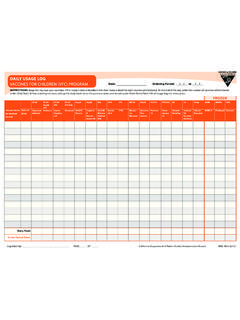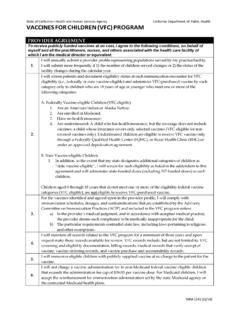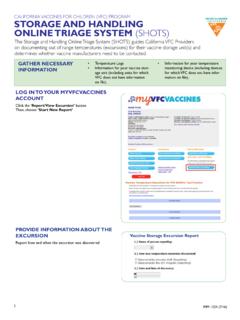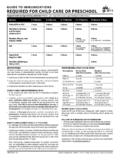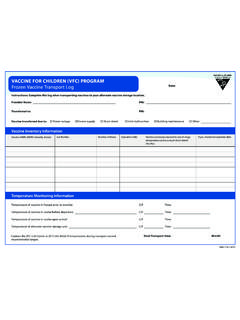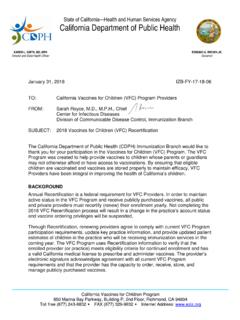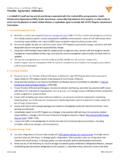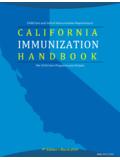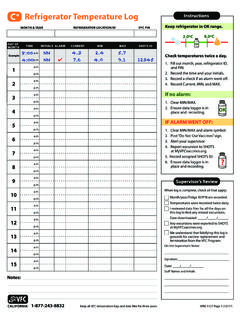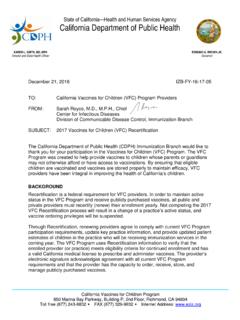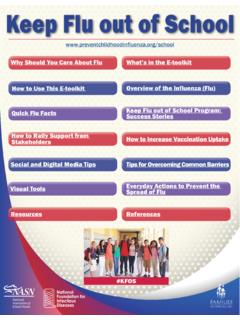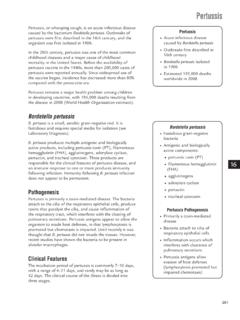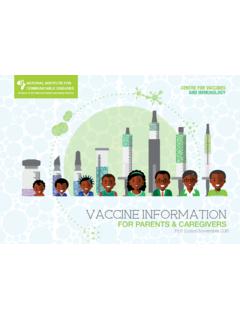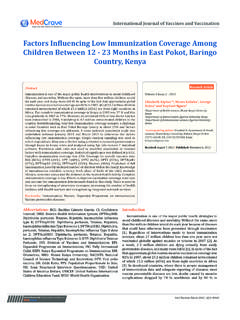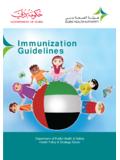Transcription of Vaccines for Children Program - EZIZ
1 IMM-1248 Vaccines for Children Program Provider Operations Manual California VFC Program RICHMOND, CA iii Table of Contents Preface v Keys to a Successful Implementation vi 1. The VFC Program Introduction 3 About VFC 4 VFC Vaccines 7 Program Requirements 10 Training & Support 13 Provider Enrollment 16 Keeping You Informed 20 Quick Start Guide 21 2. Patient Vaccinations Introduction 3 Conducting Eligibility Screening & Documentation 4 Reviewing Immunization Records 11 Administering Vaccines 14 Reporting Vaccine Adverse Events 21 Billing for Vaccine Administration 22 Educational Resources for Families 25 Essential Immunization Strategies 28 3.
2 Vaccine Management Introduction 3 Vaccine Management Plan 4 VFC Temperature Logs 7 Vaccine Storage Unit Specifications 9 Configuring Vaccine Storage Units 15 Data Logger Specifications 25 Configuring Data Loggers 29 Receiving Vaccine Deliveries 33 Storing Vaccines 38 Monitoring Storage Unit Temperatures 40 Taking Action for Temperature Excursions 45 Conducting a Physical Vaccine Inventory 47 Transferring Vaccines between Providers 52 Transporting Vaccines 55 Responding to Vaccine-Related Emergencies 62 Reporting Spoiled, Expired, or Wasted Vaccines 65 4.
3 Vaccine Orders Introduction 3 Submitting Routine Vaccine Orders 4 Correcting Denied Orders for Routine Vaccines 14 Ordering Flu Vaccines 19 iv 5. Provider Accountability Introduction 3 Vaccine Accountability 4 Fraud & Abuse 7 Site Visits 9 Record Retention 12 Annual Recertification 13 Suspension & Termination 15 6. Appendices Glossary iii Professional Resources vii Provider Agreements ix v Preface Overview The Vaccines for Children (VFC) Program s Provider Operations Manual (POM) is a reference guide that helps health-care providers stay compliant with VFC Program requirements.
4 By complying, providers can increase immunization levels in their patient populations, ensure Vaccines are administered at the recommended ages, and protect vaccine viability following manufacturers recommendations for storage and handling. How to Use the POM This reference guide provides clear instructions that help providers incorporate VFC Program requirements and best practices into their existing practice protocols. Providers and key practice staff can reference the POM as they complete necessary patient immunization and vaccine management tasks.
5 Providers are encouraged to store this manual within easy reach and instruct staff to refer to it as needed to ensure tasks are completed in compliance with Program requirements that protect patients and Vaccines . Terminology This manual contains requirements, best practices, and procedures. It is important to understand the intent of each term and how they are used. Program requirements are federal or state VFC Program policies that enrolled providers have agreed to follow. Procedures are instructions that walk staff through key immunization tasks.
6 If the instructions are followed, providers will be complying with VFC Program requirements and best practices. Best practices are recommendations shared by CDC and the California VFC Program to improve efficiencies; best practices often evolve into requirements. Target Audience Each topic in the POM is associated with common roles that might assume responsibility for completion of the discussed tasks in compliance with Program requirements. In many practices and clinics, the office manager or supervisor might be responsible for completing or overseeing some tasks.
7 However, key Program roles should be familiar with the contents of this document. Each practice should determine how to best make use of their staffing resources to incorporate VFC Program requirements into existing practice protocols. POM Structure This manual is divided into chapters that assemble related topics, and each topic is structured using repeating elements to increase readability and ease of reference: overview requirements best practices procedures notes(includes citations and additional resources) Each chapter also includes an organizational graphic (see right) that summarizes key concepts to be addressed across the chapter s topics.
8 Keeping the POM Current The California VFC Program updates and revises information as needed and communicates those changes to providers. Replace relevant sections in this manual as instructed to ensure it reflects current Program policies and procedures. vi Keys to a Successful Implementation Overview Provider involvement. The VFC Provider of Record should be directly involved to ensure high quality of care provided to patients.
9 Since providers are responsible for replacement of Vaccines spoiled or expired due to negligence, management should also have a clear understanding of the vaccine replacement costs and the clinical implications of mismanaged Vaccines . Well-trained Vaccine Coordinator & Backup roles. The VFC Vaccine Coordinator and Backup roles bear the important responsibility of implementing and overseeing the practice s vaccine management plan, and success requires well-trained staff. However, a national survey conducted by the CDC in 2015 revealed that the Backup Vaccine Coordinator and other key practice staff not routinely performing vaccine management tasks were insufficiently trained, indicating areas where practices can improve.
10 The same survey revealed the following data (see figure 1) about the designation of vaccine management responsibilities by role in California: FIGURE 1. 2015 CDC survey results for CA depicting typical designation of tasks by role. VFC-compliant storage units and calibrated temperature monitoring devices. Selection of the appropriate vaccine storage units to meet practice immunization volume is essential to maintaining stable vaccine temperatures. Properly calibrated temperature monitoring devices ensure that recorded temperatures are accurate.
